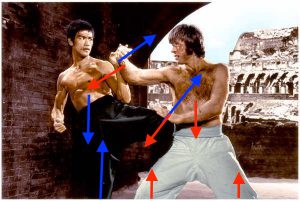
Now that we have discussed how an object moves, we turn to what causes an object to move. This was worked out by Sir Issac Newton and are usually called Newton’s Laws. Newton proposed 3 fundamental laws of motion that we can use to explain why things move and not just how they move.
Newton’s first law is about what objects do if left alone. It can be stated something like the following (the original is in Latin and uses language differently than we do today).
An object at rest stays at rest and an object in motion will stay in motion unless acted upon by an outside force
That an object at rest will continue to not move is something we all know from common experience, but that objects in motion stay in motion is not normally how we experience the world. However, that is because normally objects are effected by air resistance and friction, when those can be removed we see that objects do in fact continue at their same speed in a straight line if no force acts on them.
Newton’s second law is about how an object responds to a force. In words in can be stated something like
The acceleration of an object is directly proportional to the net force exerted on the object and inversely proportional to an object mass
Much simpler we can express this as an equation
.
Note you have to add up all forces on an object to get the net force, that is what the sigma signifies, sum over all forces. Also Newton’s second law as an equation also contains Newton’s first law, if the net force on an object is zero than the acceleration is zero or
if then
.
This example shows how we can use Newton’s second law to determine the amount of force needed in a situation. Newton’s third law states that
For every action, there is an equal and opposite reaction.
This means that every force always has a corresponding equal magnitude but opposite direction force. This is in many ways the most surprising of Newton’s Laws since it often doesn’t appear to be true. However, if we look carefully we will always find an equal and opposite force for any force we consider. As an equation we can write
Force Diagrams
To use Newton’s Laws to solve a problem we want to first draw out what is called a force diagram. That is a picture of all the forces on an object. From Newton’s second law we know that if we can sum the forces on an object as vectors then the resulting net force will give us the acceleration of an object. Since this a vector equation, we really have three equations, the net force in the x direction gives us the x acceleration, the net force in the y direction gives the y acceleration and the same for z. Just like in vector kinematics, each component can be treated separately like it is a one dimensional problem.

If an object is not accelerating in a direction than the net force in that direction is zero. An object at rest must have all forces on it balanced so that there is no net force.
Many forces are hard to calculate. The force of a person pushing is determined by muscles, bones and tendons, how you use them and the biochemistry that goes on inside them. The force of many things can be equally complex. For these complex forces we will just treat the force as a value, without understanding what causes the force to have that value. However, there are some forces that we can calculate their magnitude based on simple equations.
Weight
One force that we are all familiar with is weight. For objects on the surface of the Earth their weight is just proportional to their mass
Notice that using Newtons second law we can see that the weight of an object causes it to have a constant acceleration of g. Most objects, however, are not falling, which means their weight must be balanced by another force. This is often the normal force from the surface of a solid.
Normal Force
The normal force is a name we give to the force exerted by a surface that keeps you from going through it. Many solids have atomic structures that resist the forces applied to them. This allows the ground and floors and chairs to hold up things. The source of this force is intermolecular forces and very complex. However, the effect of the normal force is usually easy to determine. If you stand on the ground and you don’t accelerate up or down then the normal force of the ground must be exactly the force of you weight pushing down on the ground. If you push a wall with 60N of force and don’t break the way, then the wall must push back with exactly 60N of force is your hand is unmoving. Thus the normal force is exactly the amount of force needed to keep an object from going through a surface. Note that this force changes to be whatever it needs to be to keep the object from going through the surface. If you put a book on a table the normal force opposes it weight. If you then push down on the book the normal force increases to be the weight of the book plus your push. If instead you pull up on the book the normal force decreases to be the weight minus your pull. We usually denote the normal force by .
Force of Friction
Another force that is very common is friction. Friction is so common that in most problems we choose to ignore it. Friction is caused by forces between molecules and is very complex. In detail it depends on the substances involved, the relative velocity of objects and the force between surfaces. If you have a heavy table that you want to move do you pull up on the table when you try to move it or push down. Most of us have experience where you pull up on the table and then push it in the direction you want to move it. This isn’t just to keep it from scratching the floor, this is also because it reduces the force of friction when you reduce the normal force pushing up on the table.
There are actually two types of friction; static and kinetic. Kinetic friction is the friction force a moving object has and can be described approximately by
where is the normal force and
µ is called the coefficient of kinetic friction and is a number that depends on the materials involved. Note that this is not a vector equation, the direction of the friction force is not in the direction of the normal force, but instead opposed the velocity of the object. The value of the coefficient of friction must be given to you or you can look it up on the internet.
Static friction is the friction force from an object that is not moving. You probably have experience where you have noticed that these two are not the same. An object that resists being pushed, but then once it starts moving is much easier to push. Depending on the substance these two can be almost the same or the static coefficient of friction may be two or three times higher.
The other important difference in static friction is that the formula gives the maximum static friction the object can have. However, like the normal force, static friction only opposes forces that may be on the object. If you do not push an object then there is no static friction force on it. If you only push it gently then there is only a small static friction force on it, just enough to oppose your push. The above equation tells us the maximum static friction force one can have, that is the minimum force you’ll need to get the object to actually move.
Drag Force
Another important force is a drag force. This is a type of friction usually the type caused by a gas or liquid, though one can also refer to the friction from a solid as a drag force. The key thing about drag forces is that they increase with an objects velocity. So
where b is a horribly complex constant that depends on the shape and material of the object and how it interacts with whatever it is moving against. We can see that the drag force is a very difficult force to work with because it depends on the objects velocity, which depends on acceleration which depends on the forces acting on the object. This usually can only be solved as a differential equation. The drag force creates a maximum velocity for most objects called a terminal velocity. This is the velocity where the drag force is equal to the force accelerating the object. If the object went any faster then the drag force would exceed the other forces on the object slowing it down. In practice this gives up upper limit to the speed of most objects if they move through the air or water or are in contact with the ground. For a freely falling object the drag force would equal to an objects weight so we see the terminal velocity would be given by
While we will not include the drag force in any of the problems in this course, it is important to remember that in reality it exists and limits the speed of objects. The calculations we do ignoring it are only valid when speeds are small. The terminal velocity gives you a sense of when that approximation is no longer valid.
Newton’s Law of Universal Gravity
One of the most important forces which we have already discussed is gravity. However we have only discussed gravity on the surface of the Earth. Newton’s great contribution to mechanics besides the laws of motion was his law of universal gravity, which most importantly showed that the force that makes things fall on Earth is the same force that causes the Moon to revolve around the Earth and the planets to orbit the Sun. This is the universal part, that their is one force that acts everywhere in the Universe and follows the same equation. Gravity is one of the four fundamental forces in nature which physicist have discovered. Newton explained gravity using the following expression,
That is the force of gravity between two objects is proportional to the masses of the two objects and inversely proportional the the distance between them squared. There is also a new constant, the gravitational constant which gets the letter G, and . Note that this equation obeys Newton’s 3rd law by construction, the force on one mass by a second is equal an opposite to the force on the second by the first mass. The only thing that changes in the equation is the direction of the unit vector
.
We now have two equation that cover gravity, how do we know which to apply. Well Newton’s law of universal gravity is supposed to apply everywhere, which means it should apply on the Earth’s surface too. Using the Newton’s second law and the law of universal gravity we can determine the gravitational acceleration on the Earth’s surface. Looking up the mass and radius of the Earth we get
High above or below Earth’s surface the value of the gravitational acceleration will change, but within 100km or so the change is so small we can usually ignore it. Of course if you are somewhere else besides Earth’s surface then you’ll need to use the universal law of gravity to get the local gravitational acceleration like in this example.

Mechanics Examples from the Movies by Ariyeh H. Maller is licensed under a Creative Commons Attribution-NonCommercial 4.0 International License.
Based on a work at https://openlab.citytech.cuny.edu/amaller1441sp2016/.


